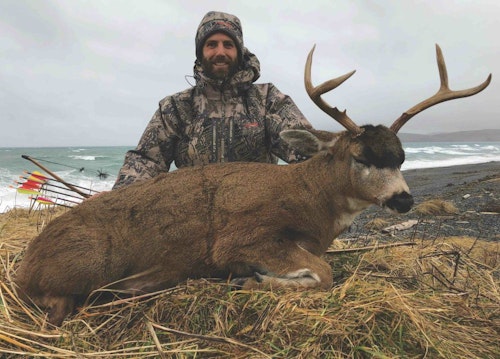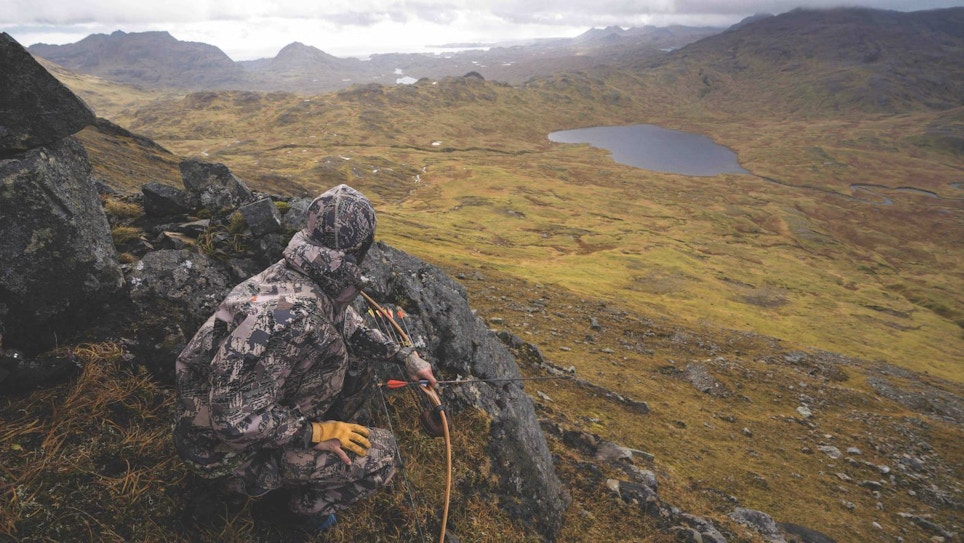I’m convinced that virtually every DIY bowhunter has a longing for adventure. For many, it’s what drives us in search of wild places and spending countless hours chasing wild things. It’s what we think about, dream about, and weave into our existence on a daily basis. Like it or not, it’s embedded deep within our DNA. Bowhunting is much more than the animals we seek and the weapon we choose to pursue them with; at its core, bowhunting is adventure!
Although adventure can be found in the smallest woodlot in the upper Midwest or the steepest mountains west of the Mississippi, the ultimate DIY adventure begins in a state known as The Last Frontier.
The wilds of Alaska are intimidating to say the least. She will chew you up and spit you out one minute, and then provide a brief moment of bowhunting euphoria the next. Although there is more information today available at our fingertips than ever before, it’s still a daunting task just laying out the pieces of the Alaska jigsaw puzzle, let alone putting them together to form a successful plan.
Alaska Learning Curve
Since 2009, Abe Henderson has been a packer, big game guide, fishing guide and duck hunting guide throughout Alaska. Henderson is an avid DIY bowhunter at heart, as well as a filmmaker, podcaster and the creator of Hunt Alaska DIY (www.huntalaskadiy.com), a service that provides informative step-by-step guides to hunting Kodiak Island’s famed Sitka blacktail deer and caribou on the Haul Road and Adak Island. As a full-time resident of Alaska and an experienced guide, he is well aware of what it takes to plan a successful hunting adventure to The Last Frontier.
As Henderson explained it, you really shouldn’t look at Alaska as a one-and-done bucket list type hunt, especially if you’re seeking adventure.
“Once you experience Alaska for the first time, you’re going to want to return,” Henderson said. Ideally, you should look at your first trip as a “total learning experience and be realistic about your expectations.” From an expense standpoint, a DIY caribou or Sitka blacktail hunt costs about the same as a DIY elk hunt out West for the bowhunter traveling from east of the Mississippi River. However, the challenges Alaska brings from a logistical standpoint, as well as her terrain, unsettling weather and hunting a new species presents a huge learning curve for the average DIY hunter.
“Although Alaska is an incredible place to experience, there is a lot to learn,” Henderson said. “The odds of a successful first hunt tend to be lower. Ideally you want to build upon each day and each experience so your next trip is even better.”
Because of the learning curve involved, picking the right game to hunt is an essential step. Although a massive Alaskan moose may be on your agenda someday, Henderson suggests a caribou or Sitka blacktail hunt be at the top of your initial list. You will not only enjoy the overall experience more, but the odds of success are considerably higher, especially on a Kodiak Island Sitka blacktail hunt.
A DIY moose hunt is challenging, insists Henderson; not only are they huge animals and a ton of work to pack out, but success rates are lower, and they often live in remote places, making the logistics more difficult. Although the experience will be one you won’t soon forget, cutting your teeth on such an adventure might be more than you bargained for right out of the gate.
When it comes to actually planning the adventure, Henderson suggests hunters squirrel away as much time as possible, “with 10 days to 2 weeks being ideal.” Although planning a week-long adventure is doable for a Kodiak Island deer hunt, that would be more of a stretch on a caribou bowhunt. With weather possibly stealing a couple days of hunting, as well as the potential need to move locations if caribou aren’t in your initial drop location, those few extra days could come in handy. “Besides, even if you tag out early, there are so many cool things to see and do in Alaska you won’t be wasting your time,” he said.

The Logistics
Once you establish what you want to hunt and the amount of time you can throw to the effort, picking where to hunt can seem impossible in a state that is over twice the size of Texas. Although blacktail deer are limited to just a few locations, making them much easier to nail down, there are 32 caribou herds across Alaska. You could start by visiting the Alaska Department of Fish and Game website and reach out to some local biologists. According to Henderson, with so much information available and the amount of locations to research, that would be a painstaking process that could leave you with more questions than answers. Instead, Henderson suggests that you find people who have been there before and pick their brains. With so many social media options available today and the ability to connect so easily, finding several people wouldn’t be a problem. You will want to glean information about general locations to start researching, as well as learn the logistical effort it will take to get there and gear required.
As for logistics, this is often the biggest hurdle for many first-timers. With so many transporters to choose from and locations to find them, it can seem overwhelming. Henderson suggests that once you establish what and where you want to hunt, locate jumping off points near that location. Bethel, Tok, Kotzebue, Kodiak, Ketchikan, Delta Junction and Wasilla are all possible hubs to consider, as well as several others. These locations will have a cluster of transporters from which to choose. While it’s easy to find negative reviews about transporters, Henderson said, “When it comes to air taxis, you have to manage your expectations. Most negative outcomes could have been avoided with a little communication up front.”
Get in Shape
Naturally, being in good physical condition is a must when planning virtually any DIY adventure. Time in the gym conditioning and building muscle tone is beneficial, as is cross-fit-type training. However, in Henderson’s experience, it’s hard to beat the benefits of a heavy backpack and hiking in steep, uneven terrain.
“Start off with a 30 pound pack and work up to 50, 60 and even 70 pounds, and start pushing yourself on some hills and ditches,” Henderson said. ”Ideally, you want to build your core and suspension so you can carry heavy loads in uneven terrain.” Keep in mind there are a lot of small muscles in your feet and ankles, so preparing these as well will enhance your overall experience on the hunt.
Lastly is mental toughness. “Eight-percent of the hunt is in your head, and pushing through the mental obstacles an Alaska hunt throws at you can make or break the overall experience,” Henderson said. “The weather alone will beat you down, and when you add some difficult terrain, isolation and potentially not seeing the game expected, you can eventually feel defeated. It’s during these times you have to have an optimistic, never quit attitude.”
That being said, it’s easy to talk about mental toughness, but it’s completely different when you’re in the middle of the experience. Before you plan your first Alaska DIY journey, Henderson suggests that you test yourself and your equipment on a western backcountry hunt first. Although the Rocky Mountain region isn’t Alaska, it will give you a little taste of what to expect. Also, purposely push yourself and your gear in poor weather conditions.
“Pitch your tent in the wind and rain, sleep out in the cold for a couple nights, shoot your bow when the weather sucks, and hike with a heavy pack in a downpour,” Henderson said. Not only will this test your gear’s performance, but it will also test your mental fortitude.

Adventure Awaits
Alaska can be the greatest bowhunting adventure of your life, but it can also be the most difficult one. As Mark Twain so eloquently explained, “Twenty years from now you will be more disappointed by the things you didn’t do than by the ones you did do. So throw off the bowlines. Sail away from the safe harbor. Catch the trade winds in your sails. Explore. Dream. Discover.”
Don’t hold back — an Alaska DIY adventure awaits you.
Sidebar: Dependable Gear for Alaska
Sitka Gear’s new Mountain Hauler 4000 is an ideal mountain pack for those extended trips. Offering 3,700 cubic inches of non-expandable space, plus the ability to expand an additional 800 cubic inches, you’ll have more than enough space to haul all the essentials. The T-6 6061 aluminum frame provides an adjustable suspension and a strong chassis so you can haul heavy loads. The Mountain Hauler also features a pair of Vertical exterior pockets, as well as numerous other pockets for organization. Add to this the tri-component molded foam shoulder yoke and hip belt, and a tough 220-denier outer shell with even tougher 450-denier underside and back panels.
Featuring powerful 15-18X magnification, the new Maven B.5 binocular features top-tier Fluorite glass for eliminating chromatic aberration, Abbe-Koenig prisms for maximum light transmission, and 56mm objective lenses for optimal light gathering. With superior edge-to-edge clarity and a large objective lens, the B.5 is designed to give hunters the edge during low-light conditions, and at only 43 ounces, they are light enough light enough for hunters to cover miles with their eyes and boots. Like all B series glass from Maven, the B.5 can be fully personalized with a variety of camo armoring, anodized accent colors, and optional engraving.
G5’s Striker V2 is a fixed, replaceable-blade broadhead with a cut-on-contact 100-percent stainless steel design. Like its predecessor, the Striker V2 has extremely sharp Lutz blades and the blade retention system on the Striker V2 features a stronger hold, increasing the broadhead’s reliability, while still keeping blade replacement extremely simple. The ferrule of the Striker V2 is fully machined stainless steel and a cutting diameter of 1.25 inches.
With three models to choose from, the new Endurance rangefinder series from Hawke will meet the needs of bowhunters and gun hunters alike. With the development of OLED technology, the Endurance series offers a fully multi-coated 6X optical system with an adjustable diopter display that features red illumination icons. This provides extremely high light transmission with true color capabilities that not only give you a precise yardage reading, but does so regardless of the angle or rain conditions. Water- and fog-proof, the Endurance series has a durable ergonomic feel and is available in 700m, 1000m and 1500m versions.







